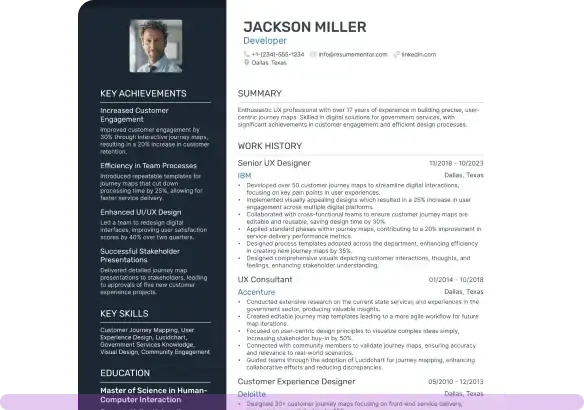Chef Resume Examples

Mar 26, 2025
|
12 min read
Craft your chef resume with a dash of creativity and a sprinkle of expertise. Learn how to sauté your skills and experience to perfection. Become the crème de la crème in the culinary world and land your dream job.
Rated by 348 people
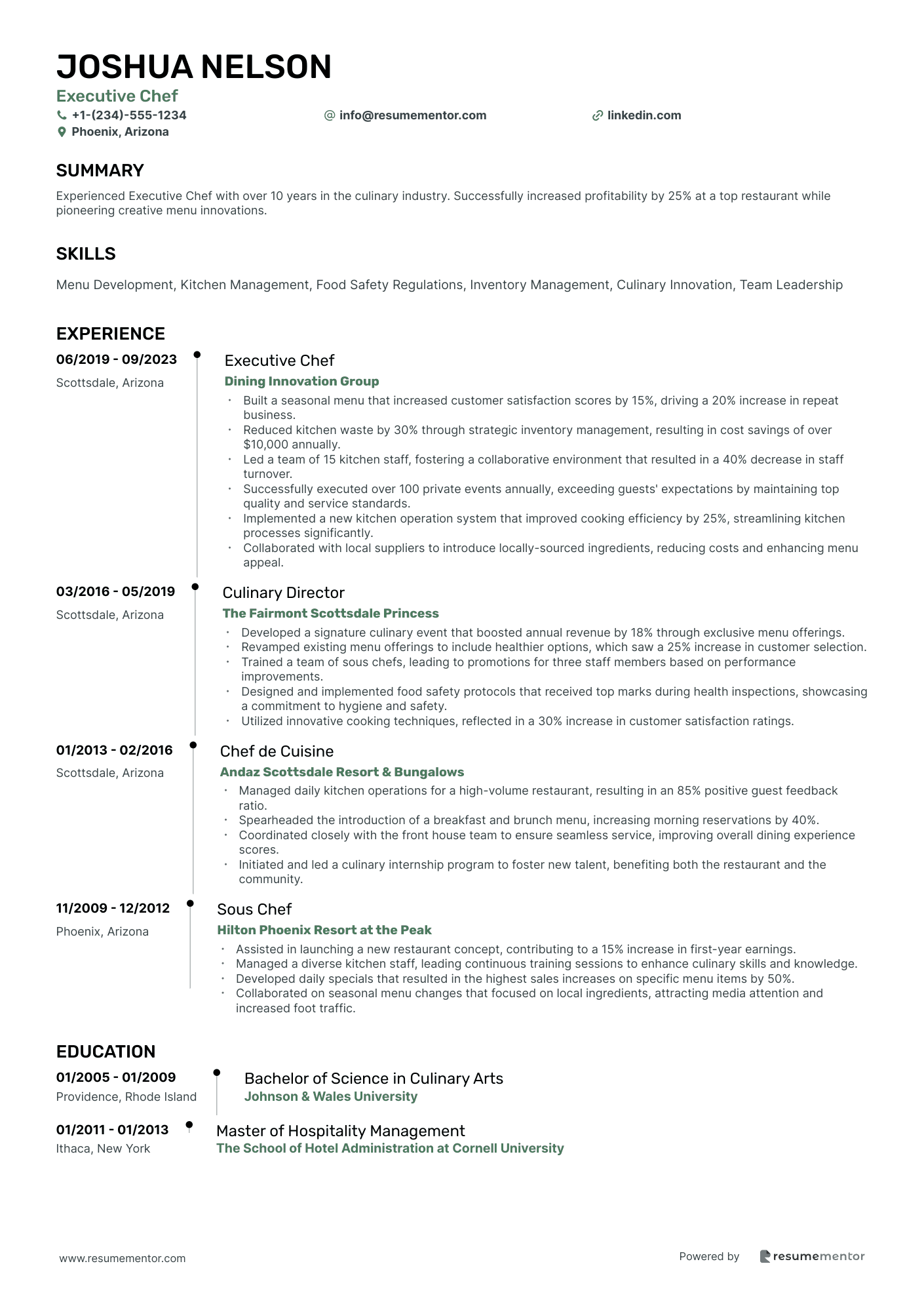
Executive Chef
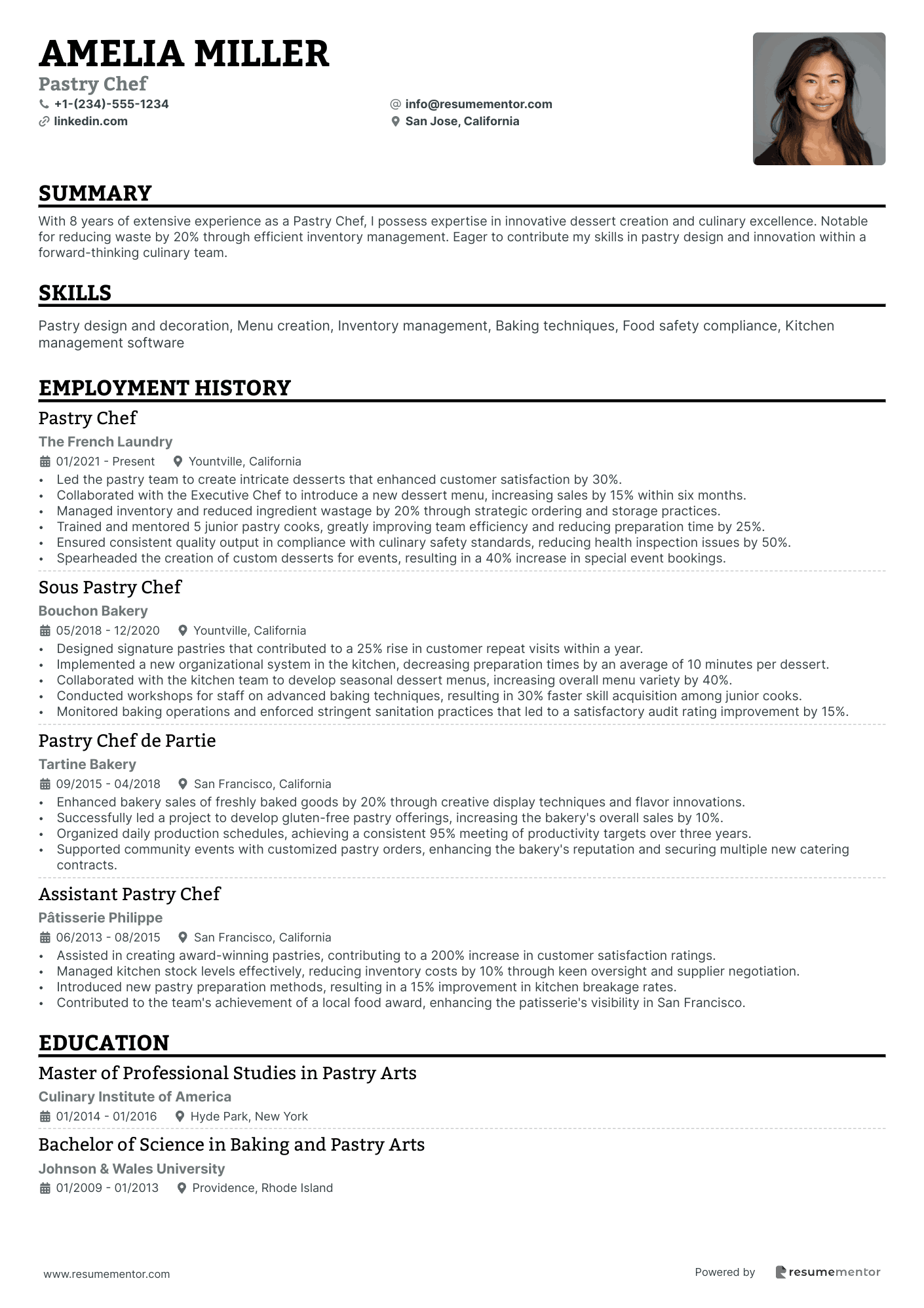
Pastry Chef
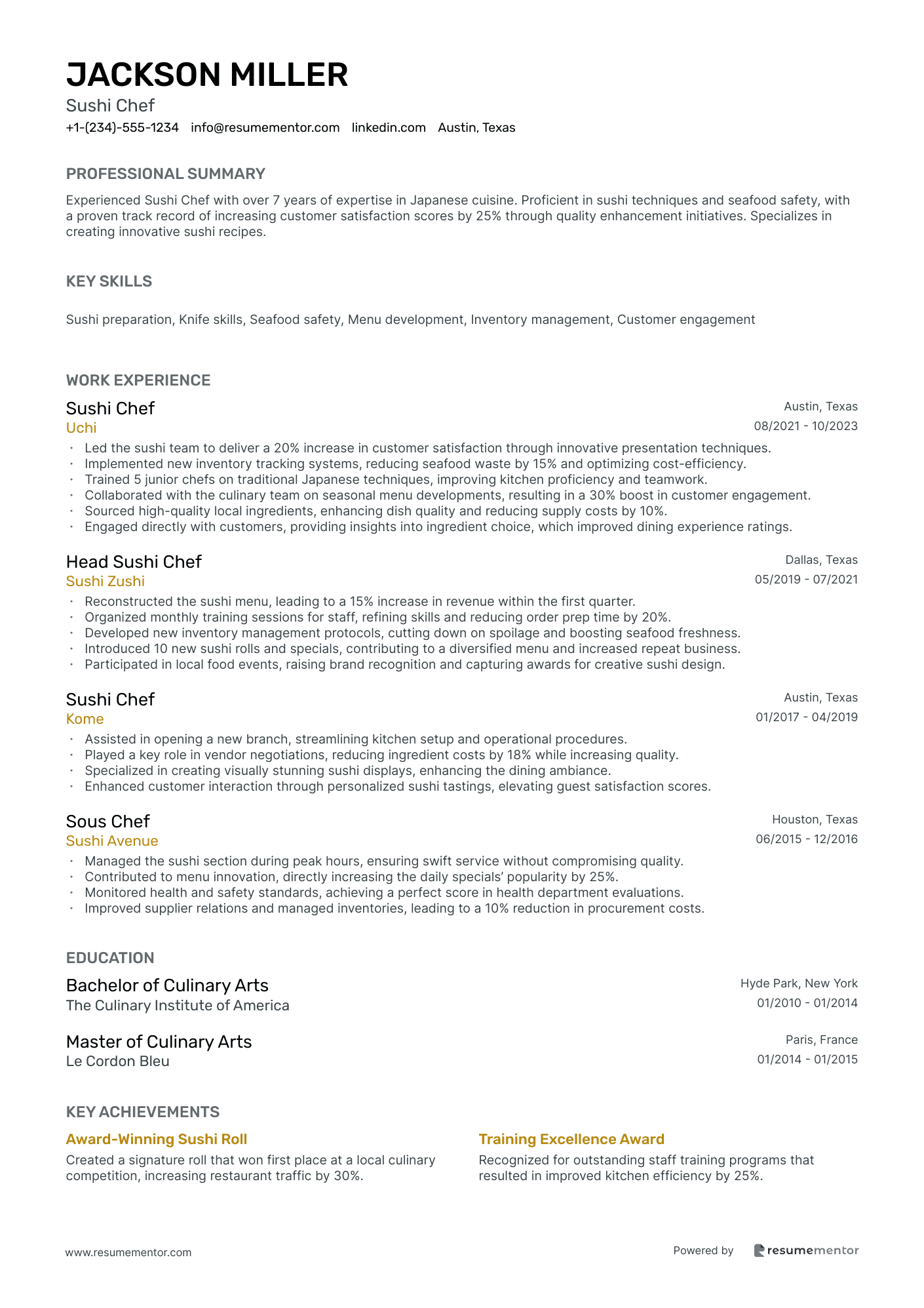
Sushi Chef
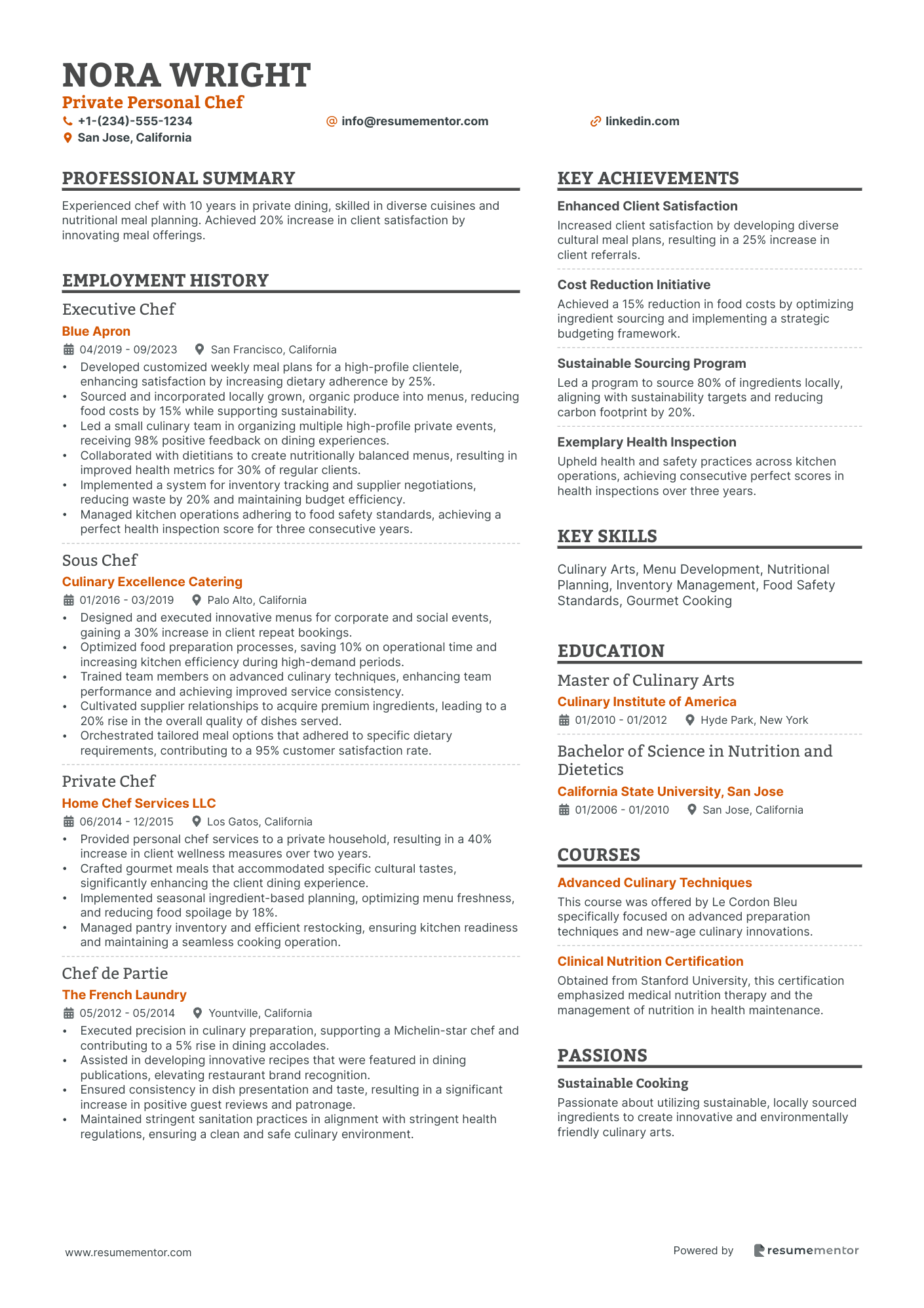
Private Personal Chef
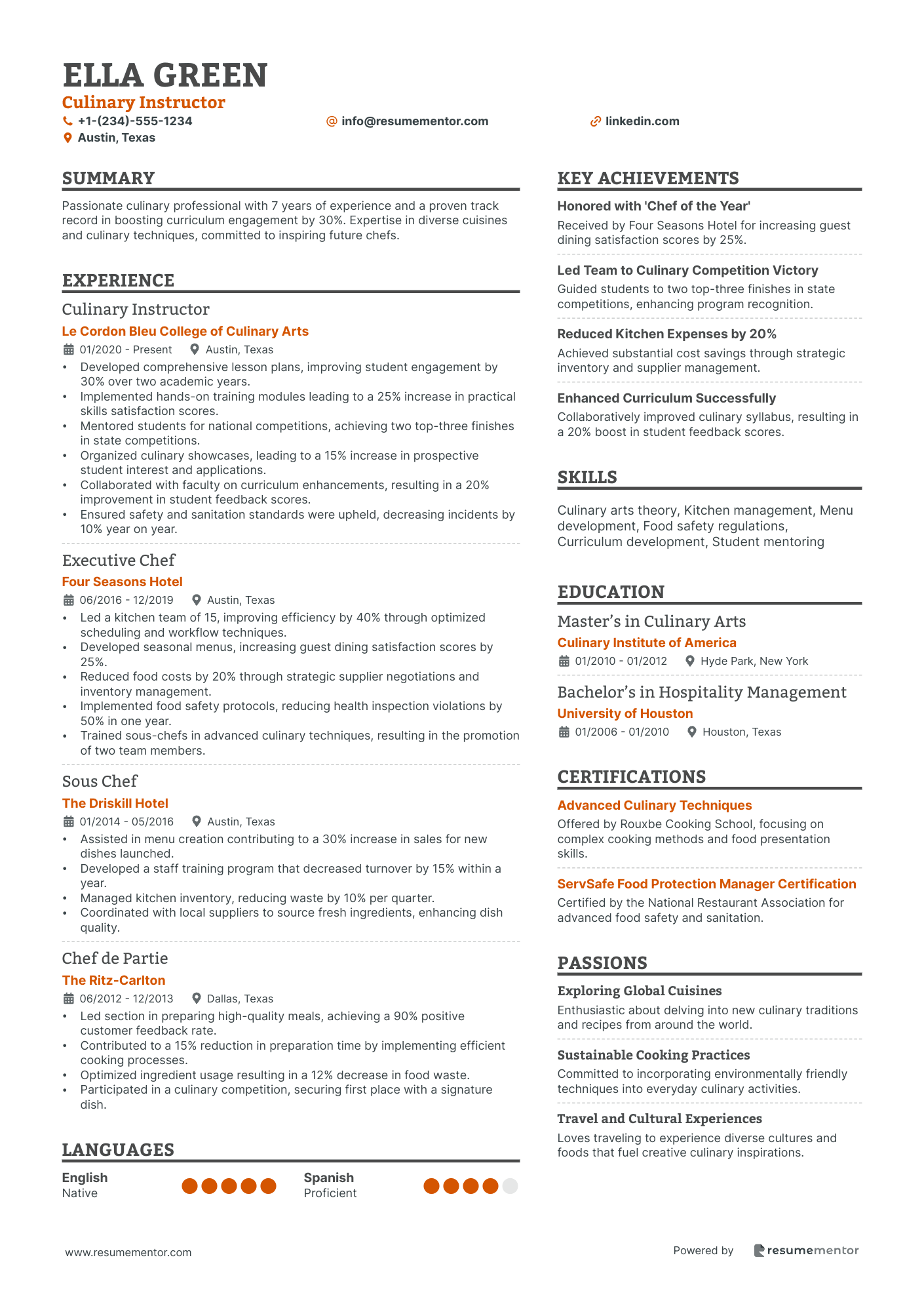
Culinary Instructor
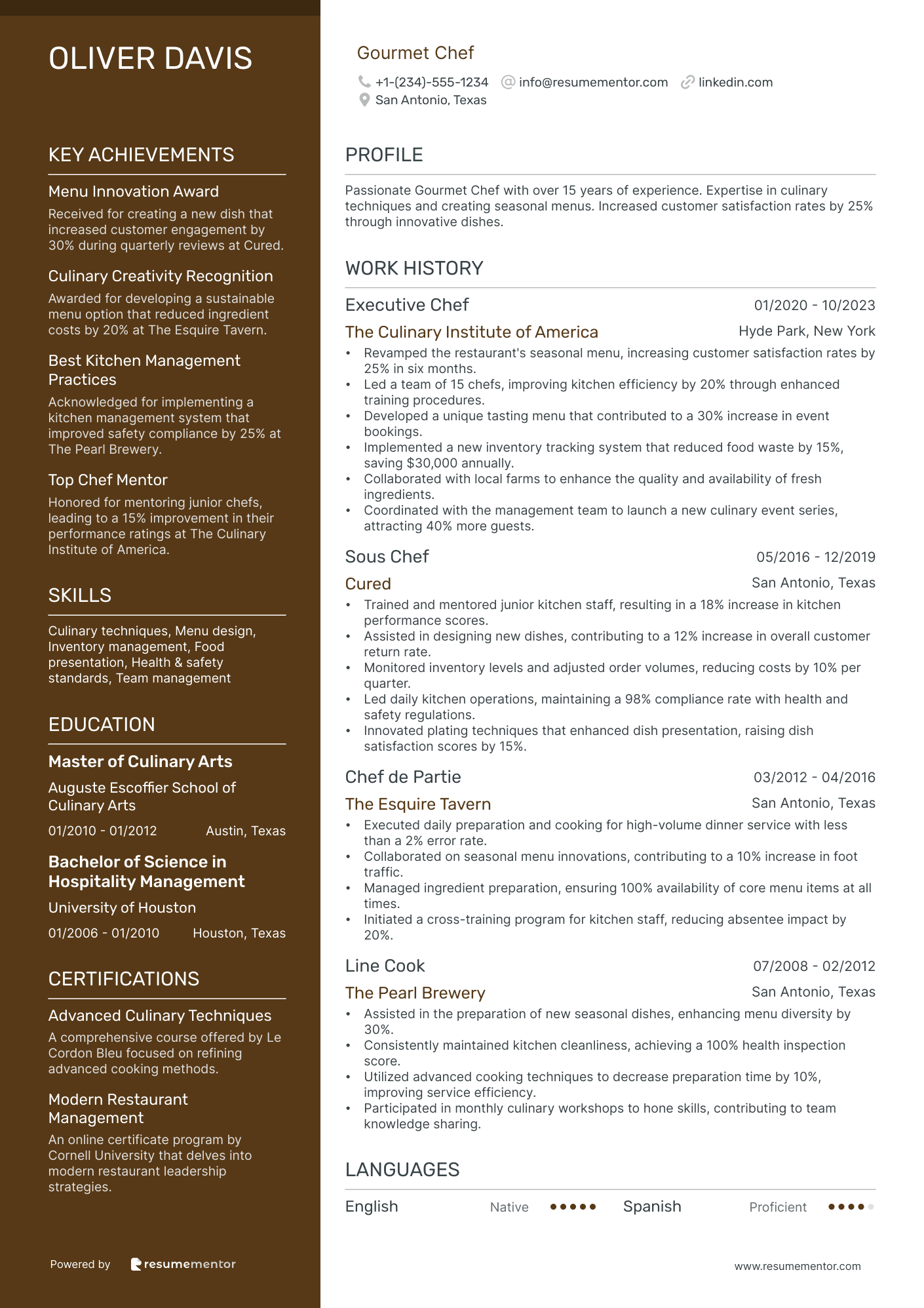
Gourmet Chef
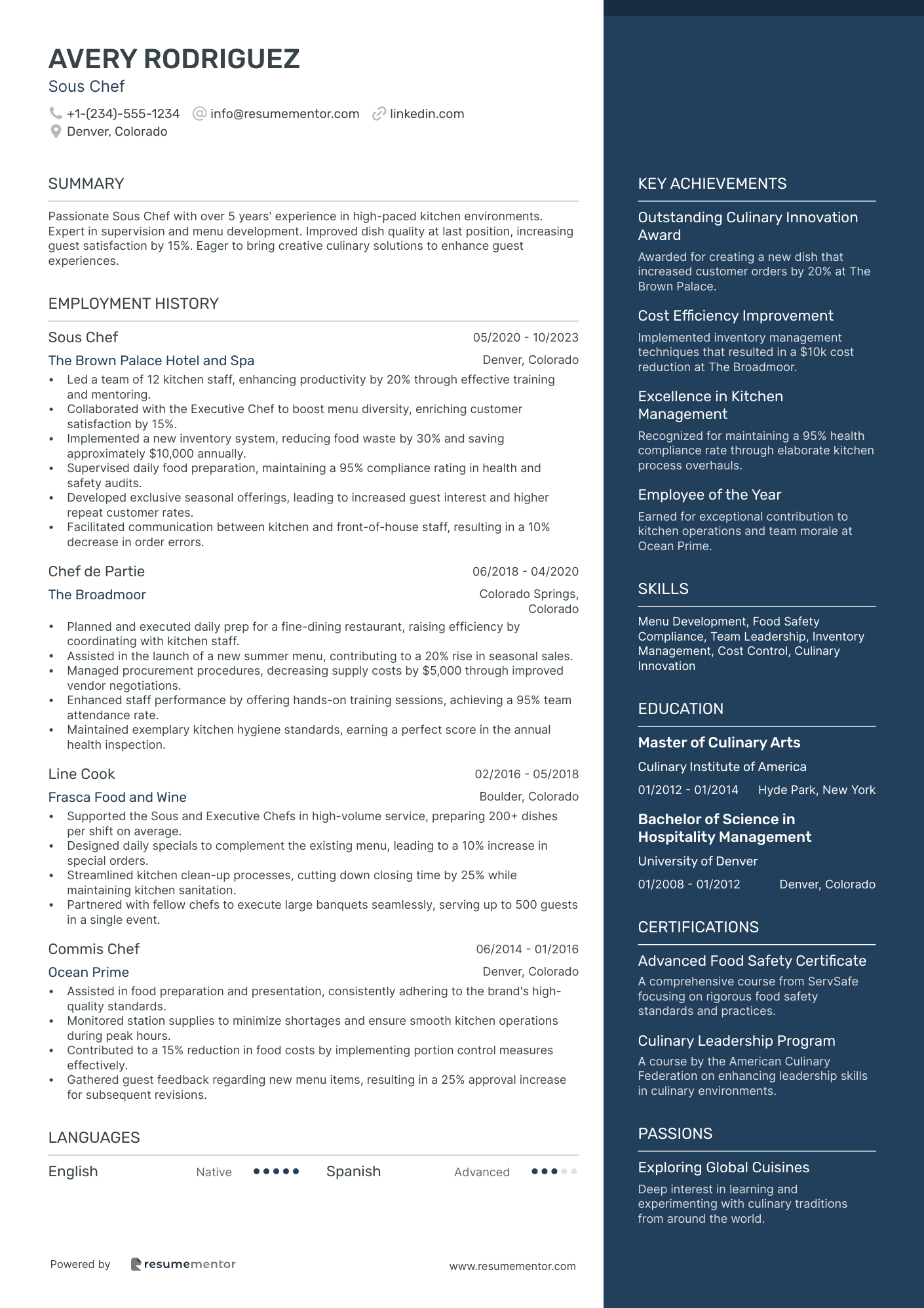
Sous Chef
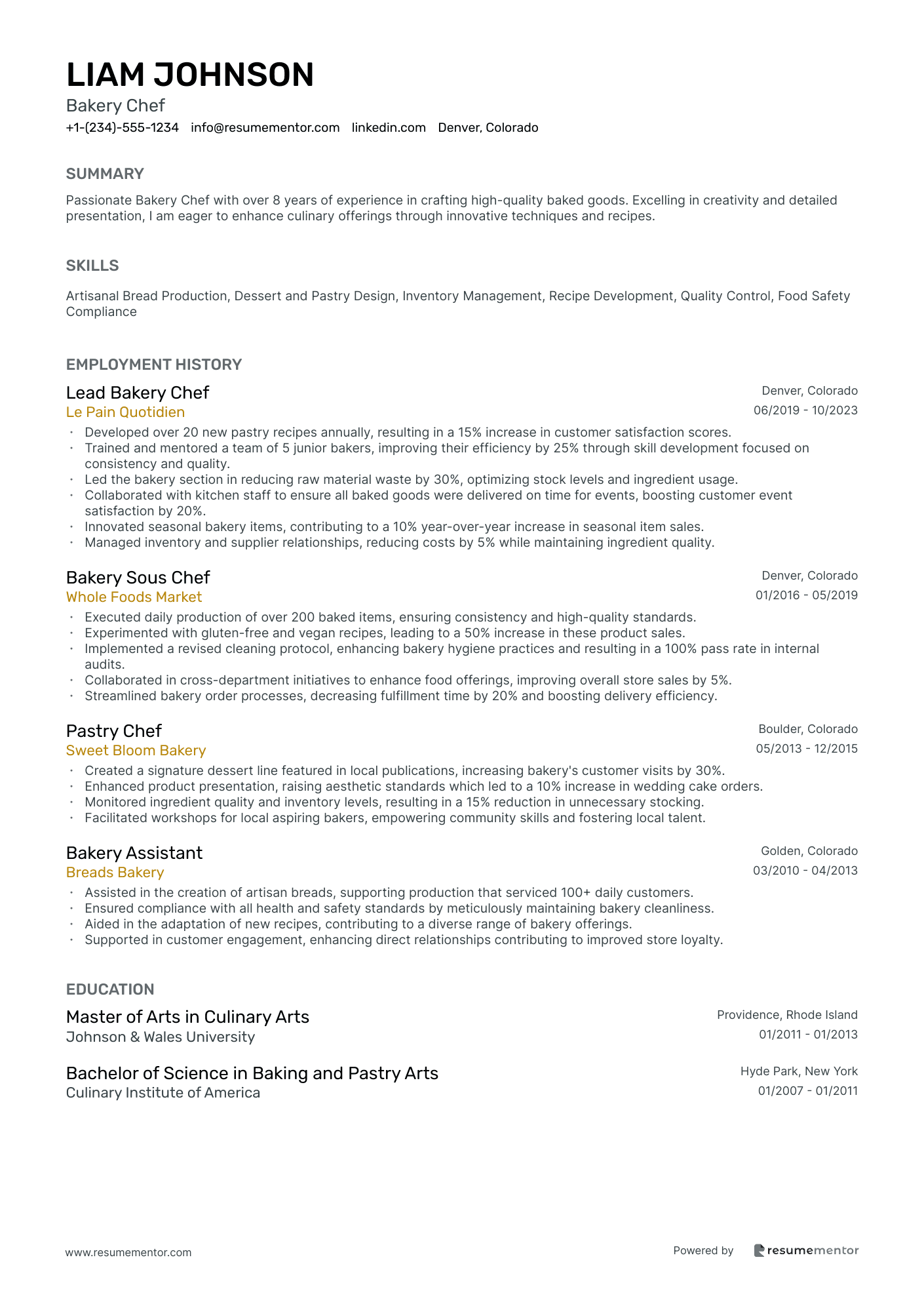
Bakery Chef
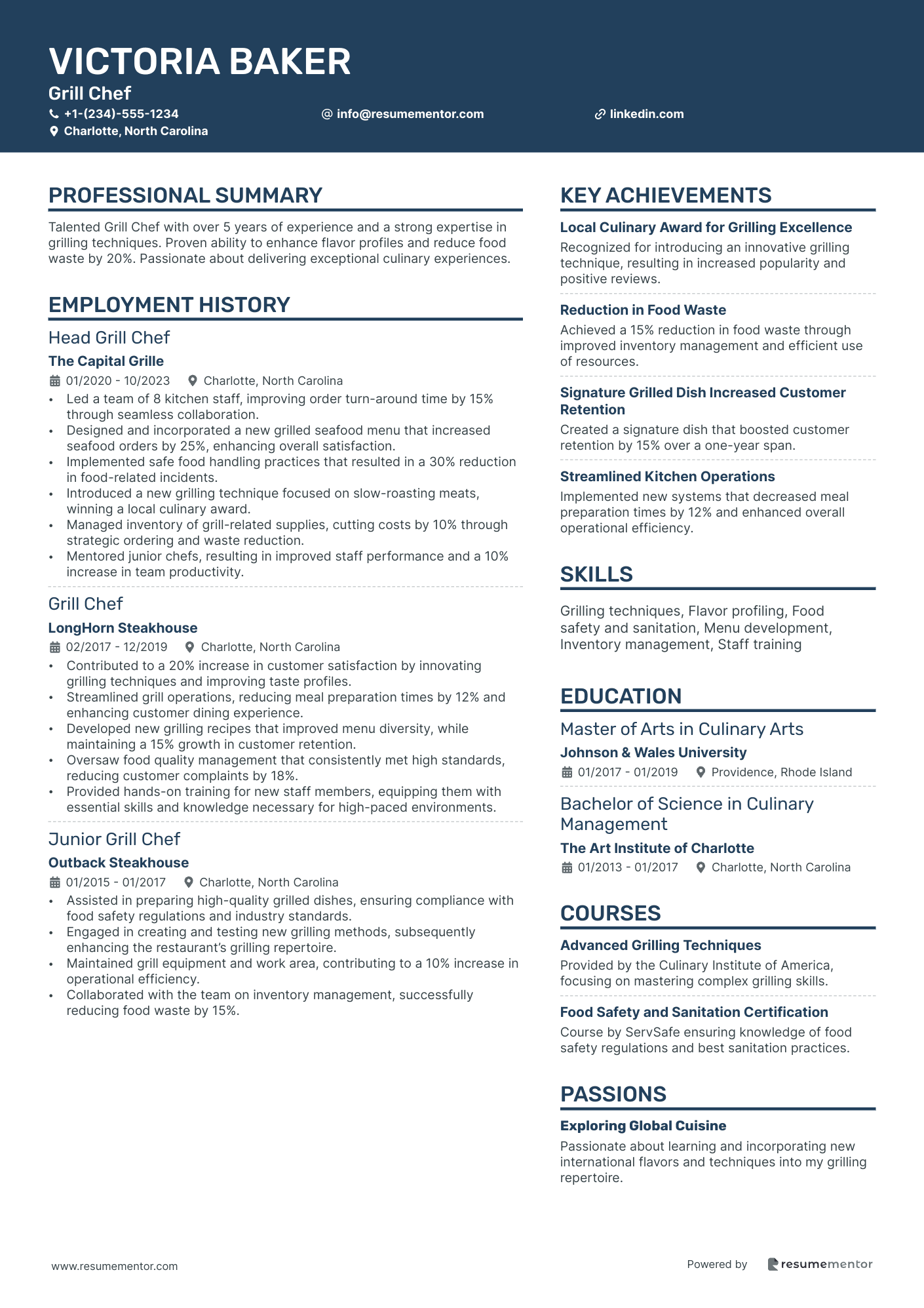
Grill Chef
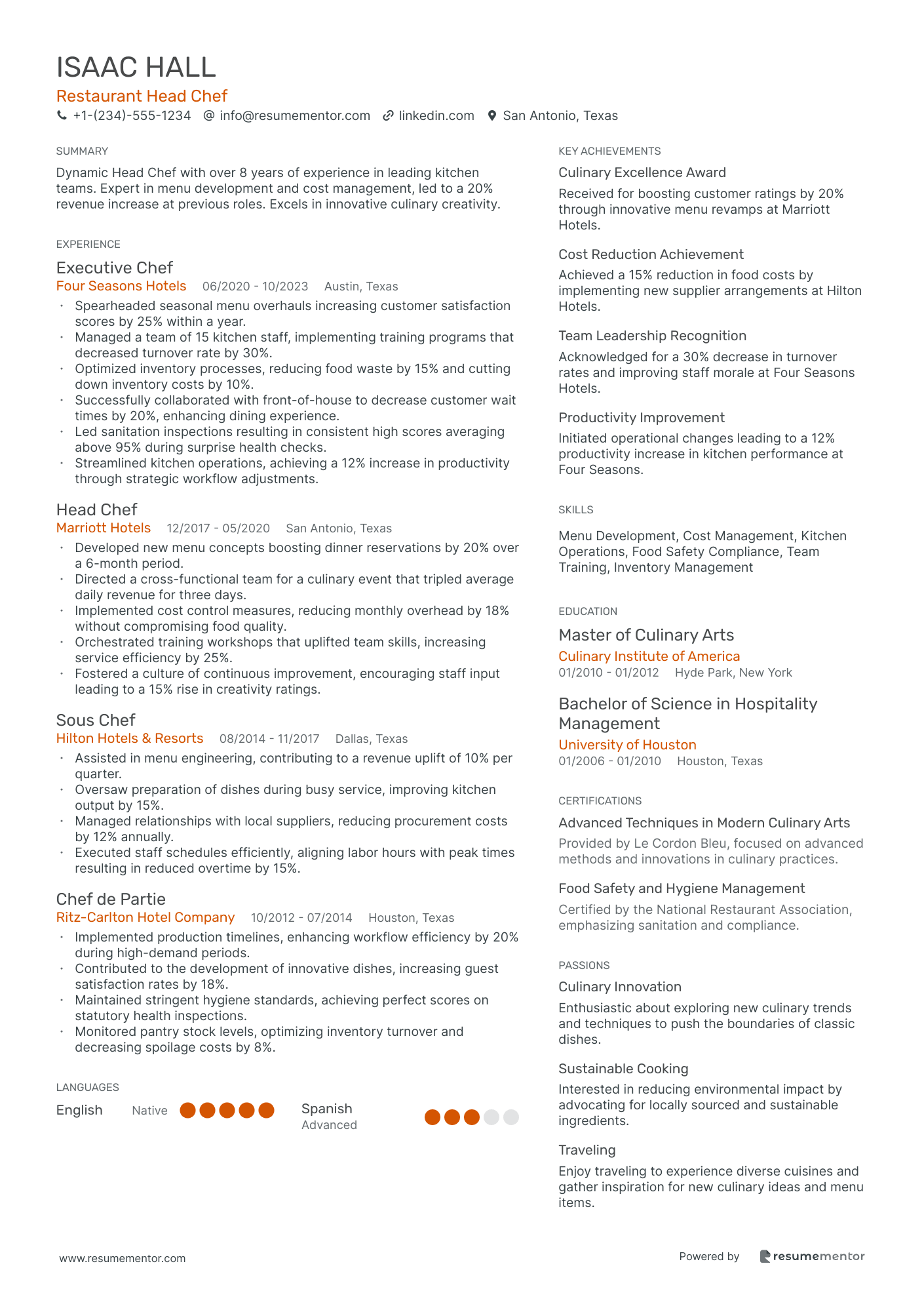
Restaurant Head Chef

Executive Chef resume sample
- •Built a seasonal menu that increased customer satisfaction scores by 15%, driving a 20% increase in repeat business.
- •Reduced kitchen waste by 30% through strategic inventory management, resulting in cost savings of over $10,000 annually.
- •Led a team of 15 kitchen staff, fostering a collaborative environment that resulted in a 40% decrease in staff turnover.
- •Successfully executed over 100 private events annually, exceeding guests' expectations by maintaining top quality and service standards.
- •Implemented a new kitchen operation system that improved cooking efficiency by 25%, streamlining kitchen processes significantly.
- •Collaborated with local suppliers to introduce locally-sourced ingredients, reducing costs and enhancing menu appeal.
- •Developed a signature culinary event that boosted annual revenue by 18% through exclusive menu offerings.
- •Revamped existing menu offerings to include healthier options, which saw a 25% increase in customer selection.
- •Trained a team of sous chefs, leading to promotions for three staff members based on performance improvements.
- •Designed and implemented food safety protocols that received top marks during health inspections, showcasing a commitment to hygiene and safety.
- •Utilized innovative cooking techniques, reflected in a 30% increase in customer satisfaction ratings.
- •Managed daily kitchen operations for a high-volume restaurant, resulting in an 85% positive guest feedback ratio.
- •Spearheaded the introduction of a breakfast and brunch menu, increasing morning reservations by 40%.
- •Coordinated closely with the front house team to ensure seamless service, improving overall dining experience scores.
- •Initiated and led a culinary internship program to foster new talent, benefiting both the restaurant and the community.
- •Assisted in launching a new restaurant concept, contributing to a 15% increase in first-year earnings.
- •Managed a diverse kitchen staff, leading continuous training sessions to enhance culinary skills and knowledge.
- •Developed daily specials that resulted in the highest sales increases on specific menu items by 50%.
- •Collaborated on seasonal menu changes that focused on local ingredients, attracting media attention and increased foot traffic.
Pastry Chef resume sample
- •Led the pastry team to create intricate desserts that enhanced customer satisfaction by 30%.
- •Collaborated with the Executive Chef to introduce a new dessert menu, increasing sales by 15% within six months.
- •Managed inventory and reduced ingredient wastage by 20% through strategic ordering and storage practices.
- •Trained and mentored 5 junior pastry cooks, greatly improving team efficiency and reducing preparation time by 25%.
- •Ensured consistent quality output in compliance with culinary safety standards, reducing health inspection issues by 50%.
- •Spearheaded the creation of custom desserts for events, resulting in a 40% increase in special event bookings.
- •Designed signature pastries that contributed to a 25% rise in customer repeat visits within a year.
- •Implemented a new organizational system in the kitchen, decreasing preparation times by an average of 10 minutes per dessert.
- •Collaborated with the kitchen team to develop seasonal dessert menus, increasing overall menu variety by 40%.
- •Conducted workshops for staff on advanced baking techniques, resulting in 30% faster skill acquisition among junior cooks.
- •Monitored baking operations and enforced stringent sanitation practices that led to a satisfactory audit rating improvement by 15%.
- •Enhanced bakery sales of freshly baked goods by 20% through creative display techniques and flavor innovations.
- •Successfully led a project to develop gluten-free pastry offerings, increasing the bakery's overall sales by 10%.
- •Organized daily production schedules, achieving a consistent 95% meeting of productivity targets over three years.
- •Supported community events with customized pastry orders, enhancing the bakery's reputation and securing multiple new catering contracts.
- •Assisted in creating award-winning pastries, contributing to a 200% increase in customer satisfaction ratings.
- •Managed kitchen stock levels effectively, reducing inventory costs by 10% through keen oversight and supplier negotiation.
- •Introduced new pastry preparation methods, resulting in a 15% improvement in kitchen breakage rates.
- •Contributed to the team's achievement of a local food award, enhancing the patisserie's visibility in San Francisco.
Sushi Chef resume sample
- •Led the sushi team to deliver a 20% increase in customer satisfaction through innovative presentation techniques.
- •Implemented new inventory tracking systems, reducing seafood waste by 15% and optimizing cost-efficiency.
- •Trained 5 junior chefs on traditional Japanese techniques, improving kitchen proficiency and teamwork.
- •Collaborated with the culinary team on seasonal menu developments, resulting in a 30% boost in customer engagement.
- •Sourced high-quality local ingredients, enhancing dish quality and reducing supply costs by 10%.
- •Engaged directly with customers, providing insights into ingredient choice, which improved dining experience ratings.
- •Reconstructed the sushi menu, leading to a 15% increase in revenue within the first quarter.
- •Organized monthly training sessions for staff, refining skills and reducing order prep time by 20%.
- •Developed new inventory management protocols, cutting down on spoilage and boosting seafood freshness.
- •Introduced 10 new sushi rolls and specials, contributing to a diversified menu and increased repeat business.
- •Participated in local food events, raising brand recognition and capturing awards for creative sushi design.
- •Assisted in opening a new branch, streamlining kitchen setup and operational procedures.
- •Played a key role in vendor negotiations, reducing ingredient costs by 18% while increasing quality.
- •Specialized in creating visually stunning sushi displays, enhancing the dining ambiance.
- •Enhanced customer interaction through personalized sushi tastings, elevating guest satisfaction scores.
- •Managed the sushi section during peak hours, ensuring swift service without compromising quality.
- •Contributed to menu innovation, directly increasing the daily specials’ popularity by 25%.
- •Monitored health and safety standards, achieving a perfect score in health department evaluations.
- •Improved supplier relations and managed inventories, leading to a 10% reduction in procurement costs.
Private Personal Chef resume sample
- •Developed customized weekly meal plans for a high-profile clientele, enhancing satisfaction by increasing dietary adherence by 25%.
- •Sourced and incorporated locally grown, organic produce into menus, reducing food costs by 15% while supporting sustainability.
- •Led a small culinary team in organizing multiple high-profile private events, receiving 98% positive feedback on dining experiences.
- •Collaborated with dietitians to create nutritionally balanced menus, resulting in improved health metrics for 30% of regular clients.
- •Implemented a system for inventory tracking and supplier negotiations, reducing waste by 20% and maintaining budget efficiency.
- •Managed kitchen operations adhering to food safety standards, achieving a perfect health inspection score for three consecutive years.
- •Designed and executed innovative menus for corporate and social events, gaining a 30% increase in client repeat bookings.
- •Optimized food preparation processes, saving 10% on operational time and increasing kitchen efficiency during high-demand periods.
- •Trained team members on advanced culinary techniques, enhancing team performance and achieving improved service consistency.
- •Cultivated supplier relationships to acquire premium ingredients, leading to a 20% rise in the overall quality of dishes served.
- •Orchestrated tailored meal options that adhered to specific dietary requirements, contributing to a 95% customer satisfaction rate.
- •Provided personal chef services to a private household, resulting in a 40% increase in client wellness measures over two years.
- •Crafted gourmet meals that accommodated specific cultural tastes, significantly enhancing the client dining experience.
- •Implemented seasonal ingredient-based planning, optimizing menu freshness, and reducing food spoilage by 18%.
- •Managed pantry inventory and efficient restocking, ensuring kitchen readiness and maintaining a seamless cooking operation.
- •Executed precision in culinary preparation, supporting a Michelin-star chef and contributing to a 5% rise in dining accolades.
- •Assisted in developing innovative recipes that were featured in dining publications, elevating restaurant brand recognition.
- •Ensured consistency in dish presentation and taste, resulting in a significant increase in positive guest reviews and patronage.
- •Maintained stringent sanitation practices in alignment with stringent health regulations, ensuring a clean and safe culinary environment.
Culinary Instructor resume sample
- •Developed comprehensive lesson plans, improving student engagement by 30% over two academic years.
- •Implemented hands-on training modules leading to a 25% increase in practical skills satisfaction scores.
- •Mentored students for national competitions, achieving two top-three finishes in state competitions.
- •Organized culinary showcases, leading to a 15% increase in prospective student interest and applications.
- •Collaborated with faculty on curriculum enhancements, resulting in a 20% improvement in student feedback scores.
- •Ensured safety and sanitation standards were upheld, decreasing incidents by 10% year on year.
- •Led a kitchen team of 15, improving efficiency by 40% through optimized scheduling and workflow techniques.
- •Developed seasonal menus, increasing guest dining satisfaction scores by 25%.
- •Reduced food costs by 20% through strategic supplier negotiations and inventory management.
- •Implemented food safety protocols, reducing health inspection violations by 50% in one year.
- •Trained sous-chefs in advanced culinary techniques, resulting in the promotion of two team members.
- •Assisted in menu creation contributing to a 30% increase in sales for new dishes launched.
- •Developed a staff training program that decreased turnover by 15% within a year.
- •Managed kitchen inventory, reducing waste by 10% per quarter.
- •Coordinated with local suppliers to source fresh ingredients, enhancing dish quality.
- •Led section in preparing high-quality meals, achieving a 90% positive customer feedback rate.
- •Contributed to a 15% reduction in preparation time by implementing efficient cooking processes.
- •Optimized ingredient usage resulting in a 12% decrease in food waste.
- •Participated in a culinary competition, securing first place with a signature dish.
Gourmet Chef resume sample
- •Revamped the restaurant's seasonal menu, increasing customer satisfaction rates by 25% in six months.
- •Led a team of 15 chefs, improving kitchen efficiency by 20% through enhanced training procedures.
- •Developed a unique tasting menu that contributed to a 30% increase in event bookings.
- •Implemented a new inventory tracking system that reduced food waste by 15%, saving $30,000 annually.
- •Collaborated with local farms to enhance the quality and availability of fresh ingredients.
- •Coordinated with the management team to launch a new culinary event series, attracting 40% more guests.
- •Trained and mentored junior kitchen staff, resulting in a 18% increase in kitchen performance scores.
- •Assisted in designing new dishes, contributing to a 12% increase in overall customer return rate.
- •Monitored inventory levels and adjusted order volumes, reducing costs by 10% per quarter.
- •Led daily kitchen operations, maintaining a 98% compliance rate with health and safety regulations.
- •Innovated plating techniques that enhanced dish presentation, raising dish satisfaction scores by 15%.
- •Executed daily preparation and cooking for high-volume dinner service with less than a 2% error rate.
- •Collaborated on seasonal menu innovations, contributing to a 10% increase in foot traffic.
- •Managed ingredient preparation, ensuring 100% availability of core menu items at all times.
- •Initiated a cross-training program for kitchen staff, reducing absentee impact by 20%.
- •Assisted in the preparation of new seasonal dishes, enhancing menu diversity by 30%.
- •Consistently maintained kitchen cleanliness, achieving a 100% health inspection score.
- •Utilized advanced cooking techniques to decrease preparation time by 10%, improving service efficiency.
- •Participated in monthly culinary workshops to hone skills, contributing to team knowledge sharing.
Sous Chef resume sample
- •Led a team of 12 kitchen staff, enhancing productivity by 20% through effective training and mentoring.
- •Collaborated with the Executive Chef to boost menu diversity, enriching customer satisfaction by 15%.
- •Implemented a new inventory system, reducing food waste by 30% and saving approximately $10,000 annually.
- •Supervised daily food preparation, maintaining a 95% compliance rating in health and safety audits.
- •Developed exclusive seasonal offerings, leading to increased guest interest and higher repeat customer rates.
- •Facilitated communication between kitchen and front-of-house staff, resulting in a 10% decrease in order errors.
- •Planned and executed daily prep for a fine-dining restaurant, raising efficiency by coordinating with kitchen staff.
- •Assisted in the launch of a new summer menu, contributing to a 20% rise in seasonal sales.
- •Managed procurement procedures, decreasing supply costs by $5,000 through improved vendor negotiations.
- •Enhanced staff performance by offering hands-on training sessions, achieving a 95% team attendance rate.
- •Maintained exemplary kitchen hygiene standards, earning a perfect score in the annual health inspection.
- •Supported the Sous and Executive Chefs in high-volume service, preparing 200+ dishes per shift on average.
- •Designed daily specials to complement the existing menu, leading to a 10% increase in special orders.
- •Streamlined kitchen clean-up processes, cutting down closing time by 25% while maintaining kitchen sanitation.
- •Partnered with fellow chefs to execute large banquets seamlessly, serving up to 500 guests in a single event.
- •Assisted in food preparation and presentation, consistently adhering to the brand's high-quality standards.
- •Monitored station supplies to minimize shortages and ensure smooth kitchen operations during peak hours.
- •Contributed to a 15% reduction in food costs by implementing portion control measures effectively.
- •Gathered guest feedback regarding new menu items, resulting in a 25% approval increase for subsequent revisions.
Bakery Chef resume sample
- •Developed over 20 new pastry recipes annually, resulting in a 15% increase in customer satisfaction scores.
- •Trained and mentored a team of 5 junior bakers, improving their efficiency by 25% through skill development focused on consistency and quality.
- •Led the bakery section in reducing raw material waste by 30%, optimizing stock levels and ingredient usage.
- •Collaborated with kitchen staff to ensure all baked goods were delivered on time for events, boosting customer event satisfaction by 20%.
- •Innovated seasonal bakery items, contributing to a 10% year-over-year increase in seasonal item sales.
- •Managed inventory and supplier relationships, reducing costs by 5% while maintaining ingredient quality.
- •Executed daily production of over 200 baked items, ensuring consistency and high-quality standards.
- •Experimented with gluten-free and vegan recipes, leading to a 50% increase in these product sales.
- •Implemented a revised cleaning protocol, enhancing bakery hygiene practices and resulting in a 100% pass rate in internal audits.
- •Collaborated in cross-department initiatives to enhance food offerings, improving overall store sales by 5%.
- •Streamlined bakery order processes, decreasing fulfillment time by 20% and boosting delivery efficiency.
- •Created a signature dessert line featured in local publications, increasing bakery's customer visits by 30%.
- •Enhanced product presentation, raising aesthetic standards which led to a 10% increase in wedding cake orders.
- •Monitored ingredient quality and inventory levels, resulting in a 15% reduction in unnecessary stocking.
- •Facilitated workshops for local aspiring bakers, empowering community skills and fostering local talent.
- •Assisted in the creation of artisan breads, supporting production that serviced 100+ daily customers.
- •Ensured compliance with all health and safety standards by meticulously maintaining bakery cleanliness.
- •Aided in the adaptation of new recipes, contributing to a diverse range of bakery offerings.
- •Supported in customer engagement, enhancing direct relationships contributing to improved store loyalty.
Grill Chef resume sample
- •Led a team of 8 kitchen staff, improving order turn-around time by 15% through seamless collaboration.
- •Designed and incorporated a new grilled seafood menu that increased seafood orders by 25%, enhancing overall satisfaction.
- •Implemented safe food handling practices that resulted in a 30% reduction in food-related incidents.
- •Introduced a new grilling technique focused on slow-roasting meats, winning a local culinary award.
- •Managed inventory of grill-related supplies, cutting costs by 10% through strategic ordering and waste reduction.
- •Mentored junior chefs, resulting in improved staff performance and a 10% increase in team productivity.
- •Contributed to a 20% increase in customer satisfaction by innovating grilling techniques and improving taste profiles.
- •Streamlined grill operations, reducing meal preparation times by 12% and enhancing customer dining experience.
- •Developed new grilling recipes that improved menu diversity, while maintaining a 15% growth in customer retention.
- •Oversaw food quality management that consistently met high standards, reducing customer complaints by 18%.
- •Provided hands-on training for new staff members, equipping them with essential skills and knowledge necessary for high-paced environments.
- •Assisted in preparing high-quality grilled dishes, ensuring compliance with food safety regulations and industry standards.
- •Engaged in creating and testing new grilling methods, subsequently enhancing the restaurant’s grilling repertoire.
- •Maintained grill equipment and work area, contributing to a 10% increase in operational efficiency.
- •Collaborated with the team on inventory management, successfully reducing food waste by 15%.
- •Supported head chefs in achieving daily production goals and maintaining consistent quality across all dishes.
- •Implemented new organizational systems, improving kitchen workflow and decreasing preparation times by 10%.
- •Assisted in training new kitchen staff, fostering a team-oriented atmosphere and improving kitchen efficiency.
- •Ensured stringent adherence to food safety and cleanliness standards, contributing to positive health inspection outcomes.
Restaurant Head Chef resume sample
- •Spearheaded seasonal menu overhauls increasing customer satisfaction scores by 25% within a year.
- •Managed a team of 15 kitchen staff, implementing training programs that decreased turnover rate by 30%.
- •Optimized inventory processes, reducing food waste by 15% and cutting down inventory costs by 10%.
- •Successfully collaborated with front-of-house to decrease customer wait times by 20%, enhancing dining experience.
- •Led sanitation inspections resulting in consistent high scores averaging above 95% during surprise health checks.
- •Streamlined kitchen operations, achieving a 12% increase in productivity through strategic workflow adjustments.
- •Developed new menu concepts boosting dinner reservations by 20% over a 6-month period.
- •Directed a cross-functional team for a culinary event that tripled average daily revenue for three days.
- •Implemented cost control measures, reducing monthly overhead by 18% without compromising food quality.
- •Orchestrated training workshops that uplifted team skills, increasing service efficiency by 25%.
- •Fostered a culture of continuous improvement, encouraging staff input leading to a 15% rise in creativity ratings.
- •Assisted in menu engineering, contributing to a revenue uplift of 10% per quarter.
- •Oversaw preparation of dishes during busy service, improving kitchen output by 15%.
- •Managed relationships with local suppliers, reducing procurement costs by 12% annually.
- •Executed staff schedules efficiently, aligning labor hours with peak times resulting in reduced overtime by 15%.
- •Implemented production timelines, enhancing workflow efficiency by 20% during high-demand periods.
- •Contributed to the development of innovative dishes, increasing guest satisfaction rates by 18%.
- •Maintained stringent hygiene standards, achieving perfect scores on statutory health inspections.
- •Monitored pantry stock levels, optimizing inventory turnover and decreasing spoilage costs by 8%.
Navigating the culinary job market is akin to mastering a complex recipe, where translating your skills onto paper can feel daunting. Crafting a chef resume involves more than just listing your experience; it's about weaving your culinary artistry, attention to detail, and adaptability into a compelling narrative. As you juggle daily techniques, flavors, and kitchen operations, the resume-writing process might seem like an unfamiliar dish to prepare.
Your resume serves as the crucial link to your next professional adventure, clearly conveying your journey and expertise in cooking techniques and kitchen management. By choosing a strong resume template, you set the stage for a layout that offers clarity and structure, much like the foundation of a perfectly plated dish.
As a chef, you're a master of mise en place, and this organizational skill can translate into creating a résumé that effectively highlights your experience, skills, and contributions to past kitchens. A well-organized resume allows potential employers to quickly grasp your value and envision you as a fit for their team.
Think of your resume not just as a document, but as the first course in introducing yourself to future employers. Approach this task with the creativity and dedication you bring to each dish, ensuring you're well-prepared for your next role in the kitchen.
Key Takeaways
- A teacher resume should clearly showcase your teaching experience, educational background, and skills that contribute to your capability as an educator, such as curriculum development and classroom management.
- Highlight your achievements and contributions in previous roles, focusing on measurable outcomes and impactful teaching methods that demonstrate your effectiveness as an educator.
- Use a simple and clean resume format that enhances readability, incorporating a professional summary to introduce your educational philosophy and teaching style.
- Include relevant certifications and continuing education to emphasize your commitment to professional development, enhancing your qualifications.
- Tailor your resume for each application, ensuring alignment with the specific requirements and expectations of different educational institutions or districts you are applying to.
What to focus on when writing your chef resume
A chef's resume should seamlessly communicate your culinary expertise, passion for food, and ability to excel in a bustling kitchen environment. It’s essential to highlight your creativity in menu development and commitment to food safety, as these qualities naturally showcase your leadership skills in the kitchen.
How to structure your chef resume
- Contact Information: Start with your full name, phone number, email, and location—ensuring recruiters have everything necessary to get in touch with you is vital. Ensure your email address is professional, as it reflects your attention to detail.
- Professional Summary: This section is where you provide a powerful snapshot of who you are as a chef. Briefly summarize your unique culinary style and flavor influences—emphasizing your years of experience and standout achievements that set you apart can create a compelling first impression that draws recruiters in.
- Culinary Experience: Detailing your work history is crucial. Focus on roles and responsibilities that led to successful cooking and team management. Emphasize specific techniques you excel at or kitchen environments where you've thrived—these details paint a vivid picture of your capabilities and emphasize your adaptability.
- Education and Certifications: This part should reinforce your culinary foundation. Including your degree in culinary arts and any certifications such as ServSafe or HACCP shows your commitment to maintaining industry standards and continuous learning, adding credibility to your profile.
- Skills: List and detail skills crucial for a chef, like menu creation and cost control. Highlight particular areas of expertise, whether it’s a specialty in international cuisines or a knack for kitchen technology—this showcases a well-rounded skill set that matches the diverse demands of a chef’s role.
- Awards and Recognitions: Any culinary awards or accolades you’ve earned should be highlighted here to reinforce your reputation and excellence as a chef. They provide tangible proof of your talents and achievements in the culinary world, which can give you an edge over other applicants.
Now that you've got the core components, it's essential to understand how to structure your chef resume effectively. Below, we'll delve into each section more in-depth to ensure your resume presents you as the top candidate.
Which resume format to choose
Crafting a chef resume in the fast-paced culinary industry requires a strategic approach that highlights your unique skills and experiences. The reverse-chronological format is ideal, as it prioritizes your most recent roles and achievements, allowing employers to quickly see how your current skills can add value to their kitchen. This approach not only makes it easier for employers to understand your career progression but also demonstrates your readiness to bring fresh ideas and techniques to their team.
Choosing the right font is essential in making your resume visually appealing and easy to read. Modern options like Rubik, Lato, or Montserrat provide a clean look that supports readability without distracting from the content. A well-chosen font can subtly convey professionalism and attention to detail, qualities that are crucial in the culinary world where precision is key.
Always save and send your resume as a PDF to maintain its layout and formatting across all devices. This simple step shows that you care about presentation, much like how plating a dish beautifully complements its flavors. It reflects a chef's natural inclination to present their work in the best possible light, ensuring no details are lost or jumbled.
Setting your margins to one inch on all sides provides a neat and organized appearance, avoiding a cluttered look that might overwhelm the reader. Proper spacing helps guide the employer's eye through your work history and skills, akin to how a well-organized kitchen promotes efficiency and flow. By paying attention to these details, you emphasize your organizational skills and the care you take in crafting every aspect of your culinary career.
How to write a quantifiable resume experience section
A strong chef resume experience section is crucial for grabbing a potential employer’s attention and setting yourself apart. This section should seamlessly highlight your relevant skills and accomplishments to paint a vivid picture of your professional journey. Start by organizing it in reverse chronological order, kicking off with your most recent position. It's essential to include job titles that match your expertise, like Executive Chef, Sous Chef, or Line Cook, so that your desired role is clear. Focusing on the last 10-15 years ensures your experience remains impactful and timely. Tailoring your resume for each application is key; carefully review the job ad and align your experience with the skills and responsibilities they seek. Use dynamic action verbs such as "spearheaded," "optimized," or "transformed" to powerfully convey your achievements.
- •Boosted revenue by 25% in 18 months by revamping the menu and introducing seasonal dishes.
- •Led a team of 15 culinary professionals, increasing kitchen efficiency by 30% with streamlined processes.
- •Achieved a 98% customer satisfaction rate through high-quality food standards and presentation.
- •Cut food costs by 20% through smart inventory management and supplier negotiations.
This chef resume experience section is designed to effectively showcase your expertise and leadership in a competitive culinary world. By including quantifiable achievements, it offers a clear glimpse of your impact, making your accomplishments tangible. Increasing revenue and reducing food costs reflect your financial acumen, while boosting customer satisfaction highlights your commitment to quality and excellence. Each bullet point is carefully selected to align with the typical responsibilities of an Executive Chef, ensuring that your experience stands out as both relevant and impressive.
The flow of this section is enhanced by its clarity, organization, and direct relevance to the role. Action verbs like "boosted," "led," and "achieved" seamlessly connect your contributions, painting a dynamic picture of what you bring to the table. Aligning your skills and achievements with the expectations of the job role enables hiring managers to easily recognize your potential value. By concentrating on recent experience, your skills and successes are presented as current and well-suited to the industry's evolving demands.
Problem-Solving Focused resume experience section
A problem-solving-focused chef resume experience section should emphasize the moments when your actions made meaningful differences in your work environment. Start by identifying specific situations where you tackled challenges head-on and crafted effective solutions. Use clear, action-driven language to describe your role and the steps you took to address each issue. Whenever possible, include numbers to highlight your achievements, as these details can add impact to your examples and demonstrate your critical thinking and adaptability in a fast-paced kitchen setting.
Consider the ways your creativity and quick thinking led to smoother operations or conserved valuable resources. Detail scenarios where your decision-making skills were instrumental in finding practical solutions. Highlight successes where your interventions provided measurable benefits, like enhanced efficiency, reduced costs, or improved customer satisfaction. Each bullet point should seamlessly convey the problem you encountered, the actions you initiated, and the positive outcomes achieved, painting a vivid picture of your problem-solving prowess.
Head Chef
Gourmet Kitchen
2018 - 2023
- Resolved supply chain disruption by sourcing local alternatives, maintaining service quality without cost increase.
- Implemented a new kitchen workflow that increased food preparation efficiency by 25%, reducing customer wait times.
- Developed an alternative ingredient plan to accommodate unexpected shortages, ensuring consistent menu quality.
- Created a staff training program to handle peak service times, improving team performance and customer satisfaction.
Technology-Focused resume experience section
A technology-focused chef resume experience section should effectively highlight how technology can transform a kitchen environment. Start by giving a brief overview of your role to set the context, then seamlessly transition into specific examples that showcase your technical prowess and their positive outcomes. Delve into your experience with software, tools, or systems, and illustrate how they've played a role in streamlining processes, which can range from inventory management to enhancing teamwork. Highlighting these achievements with numbers wherever possible offers a concrete, measurable view of your contributions.
Ensure each point is articulated in a way that flows naturally, painting a cohesive picture of your tech-driven problem-solving skills. Use bullet points to organize your achievements; this format allows your successes to stand out and makes them accessible at a glance. Tailor each point to the job you’re aiming for, keeping them relevant and impactful for the role.
Head Chef
Delicious Dishes Bistro
June 2020 - Present
- Implemented a kitchen inventory management system using ChefMod, reducing food waste by 20%.
- Trained a team of five on digital ordering software, resulting in a 30% improvement in order accuracy.
- Developed a digital checklist for daily prep tasks, increasing kitchen efficiency by 15%.
- Introduced new scheduling software that decreased labor costs by optimizing staffing levels according to peak hours.
Project-Focused resume experience section
A project-focused chef resume experience section should vividly highlight the culinary projects and achievements that demonstrate your expertise. Begin by emphasizing the responsibilities you embraced and the leadership roles you undertook. Strong action verbs are key, and where possible, quantifying achievements will give a clearer picture of your skills and impact.
Zoom in on the standout projects from your career, especially those where you solved challenges or achieved remarkable outcomes. Describe your involvement and the project results. Use bullet points to present this information clearly, making it easy to see how your actions created benefits for your workplace. Ensure each bullet connects to the narrative of your professional journey, weaving a cohesive story of growth and success.
Head Chef
Gourmet Bites Restaurant
June 2020 - August 2023
- Created a farm-to-table seasonal menu that boosted customer satisfaction by 30% over two years.
- Led a kitchen team to execute a 500-guest banquet, managing budget and logistics to earn high praise and repeat business.
- Implemented a food waste reduction program that cut kitchen waste by 45% within six months.
- Partnered with local suppliers for sustainable ingredients, enhancing menu quality and reducing costs by 15%.
Collaboration-Focused resume experience section
A collaboration-focused chef resume experience section should highlight your teamwork and leadership skills within the kitchen environment. Begin by emphasizing projects where working together was crucial, such as managing workflows or collaborating on menu planning with your team. Illustrate your ability to communicate clearly and effectively, whether in team meetings, with kitchen staff, or while coordinating with suppliers to ensure smooth operations.
Next, share how these collaborative efforts led to improved work environments or significant achievements. Describe how you supported your team through mentoring or training, fostering stronger collaboration and reducing errors. Discuss how your efforts contributed to a positive work atmosphere that motivated others and enhanced the overall quality of food service. Highlight any awards or recognition received for team efforts, underscoring your contributions to shared successes.
Executive Chef
Gourmet Bistro
January 2018 - July 2023
- Led a cross-functional team of chefs and sous-chefs to successfully launch a new seasonal menu, improving restaurant patron satisfaction by 25%.
- Built strong relationships with local farmers and suppliers, ensuring fresh and quality ingredients and enhancing menu creativity.
- Developed and conducted training sessions for kitchen staff, increasing team collaboration and reducing errors by 30%.
- Organized team-building activities and workshops, fostering a positive work environment and enhancing team morale.
Write your chef resume summary section
A chef-focused resume summary should immediately capture the attention of hiring managers by demonstrating your culinary prowess and professional experience. Keep your summary concise, ideally just a few sentences that effectively convey your strengths. Using powerful action words can highlight your skills and significant achievements. The goal is to offer a clear snapshot of your professional identity, emphasizing key aspects like your culinary expertise, experience in the kitchen, and your future ambitions. If you have extensive experience as a chef, mention your years in the industry, any specialties, and accolades you’ve received. These details help showcase your unique professional personality. Consider this example for an experienced chef:
This summary works well as it effectively ties together critical traits like leadership, creativity, and quality, which are valued in the culinary world. It acts as a bridge between your past experiences and the potential role you seek, communicating precisely what you bring to a team. Unlike a resume summary, a resume objective usually outlines career goals, often utilized by those with less experience. In contrast, a summary of qualifications provides a bullet-point list of skills, while a resume profile can be more personal and narrative. Each format serves different professional needs based on career stages. However, a well-crafted summary often strikes an effective balance, blending professionalism with personal flair. Ensure each application is tailored to the role to maximize impact.
Listing your chef skills on your resume
A skills-focused chef resume should effectively highlight your abilities, giving a clear picture of what you bring to the kitchen. You can opt to showcase your skills as a standalone section or blend them into areas like your experience and summary. Emphasizing your strengths, including soft skills such as teamwork and communication, demonstrates your ability to collaborate and tackle kitchen challenges. Meanwhile, hard skills like cooking techniques and equipment proficiency reflect the specific, teachable abilities you've acquired through training and practice. Both your skills and strengths serve as important keywords, making your resume more attractive to employers and easier to find in searches.
Here's an example of how a standalone skills section might look in JSON format:
This standalone section is valuable because it is specific and relevant to the role of a chef, making it easy for hiring managers to quickly assess your qualifications.
Best hard skills to feature on your chef resume
The hard skills you include should demonstrate your technical knowledge and proficiency in running a kitchen. Here are 15 essential hard skills for chefs:
Hard Skills
- Culinary expertise
- Knife skills
- Menu creation
- Food safety and sanitation
- Kitchen management
- Cost control
- Inventory management
- Pastry and baking
- Grill mastery
- Sauce preparation
- Nutrition knowledge
- Specialized cuisine proficiency
- Catering
- Allergen awareness
- Recipe development
Best soft skills to feature on your chef resume
In addition to hard skills, soft skills are crucial. They reveal how you manage interpersonal dynamics and maintain composure under pressure. Here are 15 important soft skills for chefs:
Soft Skills
- Communication
- Teamwork
- Problem-solving
- Time management
- Attention to detail
- Leadership
- Flexibility
- Stress management
- Creativity
- Decision-making
- Adaptability
- Conflict resolution
- Customer service
- Work ethic
- Interpersonal skills
How to include your education on your resume
An education section is a key component of your chef resume. It provides insight into your academic background, allowing potential employers to assess your foundational knowledge and skill set. Tailor this section to the job you’re applying for by including only relevant education. Irrelevant qualifications can be omitted to maintain focus. If your GPA is impressive (typically 3.5 or higher), include it on your resume. Mention any honors like cum laude to highlight your academic achievements. When listing a degree, provide the type of degree, the institution, and the date of graduation.
An incorrect example of an education section might look like this:
A better example would be:
The second example is well-suited for a chef's resume. It highlights a relevant culinary degree from a respected institution, showcasing specialized knowledge. The concise presentation maintains attention on important details like the degree and school, without unnecessary clutter. This approach ensures your resume aligns with the job, making you a compelling candidate.
How to include chef certificates on your resume
Including a certificates section in your chef resume is essential. Certificates demonstrate your skills and knowledge, making your resume stand out. List the name of each certificate accurately. Include the date you received it to show your experience. Add the issuing organization to provide authenticity to your claims. Highlighting certifications in your resume header also adds value. For example, "Certified Executive Chef, American Culinary Federation" immediately grabs attention.
This example is effective because it includes well-known certifications relevant to a chef. A certification from the American Culinary Federation indicates proficiency and dedication. The ServSafe certification assures that you have knowledge in food safety, which is essential in any kitchen. Including both adds credibility to your expertise in culinary arts and safety standards. These certificates directly relate to the skills necessary for a professional chef, making them highly relevant.
Extra sections to include on your chef resume
In today's competitive culinary world, having a well-rounded chef resume can set you apart. Highlighting key sections like language skills, interests, and volunteer work can significantly enhance your appeal to potential employers. As a chef, showcasing varied skills beyond the kitchen ensures you portray a full picture of your abilities.
- Language section — List additional languages you speak fluently to show your ability to work in diverse environments and with various clients.
- Hobbies and interests section — Share hobbies like gardening or traveling, which can impress recruiters by illustrating where your cooking inspiration comes from.
- Volunteer work section — Include any unpaid experiences, like teaching cooking classes, that demonstrate your commitment to community and passion for the culinary arts.
- Books section — Mention books about cooking or food culture that have influenced your culinary style, emphasizing your dedication to continuous learning in your field.
In Conclusion
In conclusion, crafting an outstanding chef resume is an art in itself, closely resembling the meticulous preparation of a gourmet dish. Your resume acts as a bridge to your future career, showcasing your culinary skills, creativity, and leadership abilities in the kitchen. By focusing on a cohesive structure, you ensure potential employers quickly grasp your value. Using a reverse-chronological format with clear font choices ensures readability and professional presentation. Highlighting both your hard and soft skills paints a comprehensive picture, while quantifying achievements provides concrete evidence of your capabilities.
Presenting your experience with dynamic action verbs and measurable outcomes can make your resume impactful, setting you apart in the fast-paced culinary industry. Don't underestimate the importance of each section - from professional summaries to skills and certifications - as they collectively build a narrative of your professional journey. Including additional sections like interests, language skills, and volunteer work can provide a holistic view of who you are, enhancing your appeal to potential employers.
Ultimately, your chef resume should be a reflection of your passion for food and dedication to your craft. Tailoring each application to the job at hand demonstrates understanding and commitment, much like perfecting a recipe for a discerning palate. In a competitive field, your resume serves as the first taste of the unique flavors you bring to any kitchen, and when crafted with care, it can lead you to your next culinary opportunity.
Related Articles
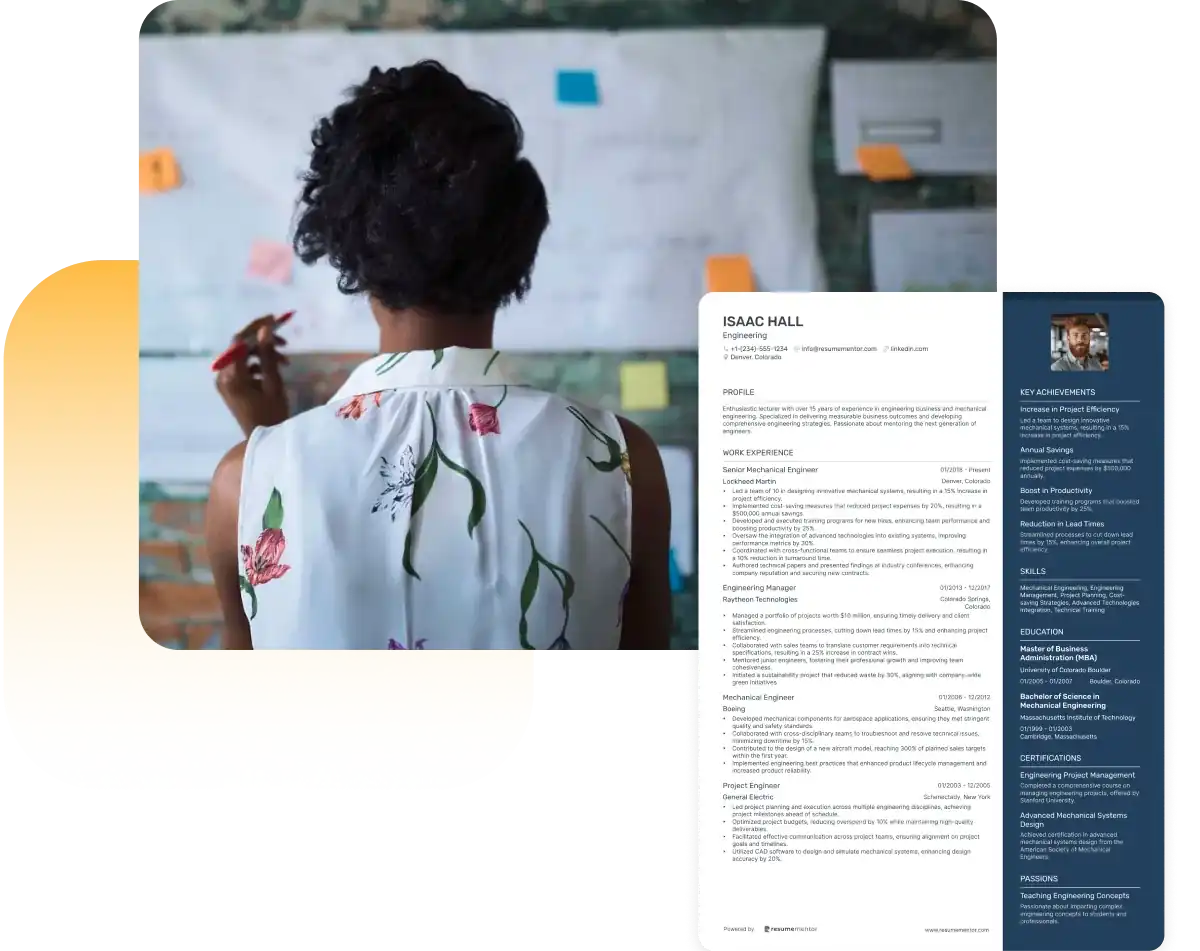
Continue Reading
Check more recommended readings to get the job of your dreams.
Resume
Resources
Tools
© 2025. All rights reserved.
Made with love by people who care.

